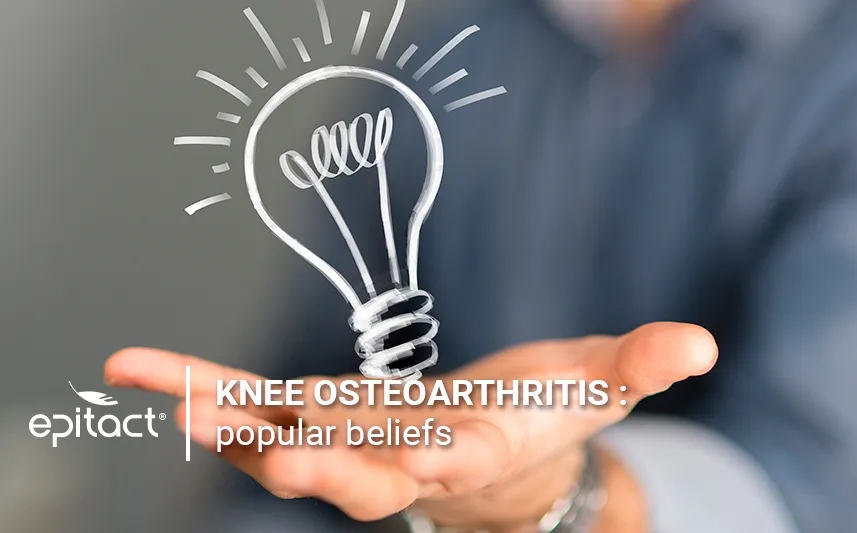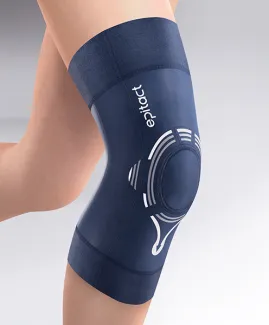
Although knee osteoarthritis is very frequent, it suffers from many popular beliefs and is finally poorly known from the general public. Between irreversibility, prevention and ageing, let’s get a grip on reality about this knee condition.
Knee osteoarthritis is a non-inflammatory degenerative condition affecting the knee joint that has mechanical causes. This chronic arthropathy is characterised by progressive degradation of the knee cartilage. With wear and tear, it can even end up totally absent, therefore causing bone contact within the joint.
Do not confuse it with arthritis which corresponds to inflammation of the knee joint. Now that you have the basics, let’s shed some light on the main popular beliefs about knee osteoarthritis.
Popular belief no.1: Resting the knee limits the progression of knee osteoarthritis.
Here is one of the main popular beliefs about knee osteoarthritis. It can be logical to believe it knowing that osteoarthritis is a mechanical wear and tear of the joint. However, it is really a misconception about this condition. In fact, physical activity is one of the first things to do to relieve the joint in the case of knee osteoarthritis(1).
For more security and support while beginning or resuming activities, opt for one of the EPITACT® knee braces created for patellofemoral knee osteoarthritis. The PHYSIOstrap™ SPORT knee brace* can be worn during any physical or sports activities. It is composed of a patented silicone tendon that surrounds the kneecap. It allows the kneecap to stay in the trochlear groove and avoids lateral deviations. It provides efficient support and joint pain relief during physical or sports activities.
NB: Practice should remain progressive, adapted and moderate. First of all, the goal is to strengthen the muscles around the kneecap. It can be done by walking, cycling or swimming or simply by staying active (gardening, do-it-yourself for example). All these daily activities also contribute to preventing and relieving pain as well as improving your range of motion.
Moreover, being overweight is a risk factor of knee osteoarthritis. Therefore, by preventing a sedentary lifestyle, you also prevent knee osteoarthritis while combining health and well-being!
Popular belief no.2: Knee osteoarthritis only affects the elderly.
Here again, further clarification is needed... Indeed, ageing is a risk factor for knee osteoarthritis, but it is not the systematic or single cause! Not all older people develop osteoarthritis of the knee, in the same way that younger people can have it.
Even if the prevalence of knee osteoarthritis increases with age, it can affect all generations. Also, women after 45 are more concerned; menopause would play a significant role in the onset of the condition...
However, it is rather the nature and intensity of activities that favour osteoarthritis of the knee. For example, high performance sports can accelerate cartilage wear. In addition to other risk factors like overweight, sedentary lifestyle or heredity, anyone can have osteoarthritis!
Popular belief no.3: Nothing can prevent knee osteoarthritis.
We’re now aware that many factors increase the risk of developing knee osteoarthritis. Age is one of them but it doesn’t mean we’ll all have it one day. Several preventive measures exist to avoid this. Logically, preventing knee osteoarthritis begins with fighting against its risk factors.
For this purpose, have a good hygiene of life, try losing weight if necessary and avoid a sedentary lifestyle. It is also necessary to properly treat potential traumas (fractures, cruciate ligament rupture) and repeated microtraumas in the knee. These tips greatly limit the risks of osteoarthritis of the knee, but others exist...
You should also think about resting your joints. Activities that are too intense or harmful for the knee could also favour its onset. On the one hand, identify the risky sports activities for the joints (bodybuilding, contact sport, etc.). On the other hand, occupations that involve prolonged and repeated supports on the knees can also aid the onset of knee osteoarthritis.
Discover more ways of protecting the joint with our article about the causes and risk factors for knee osteoarthritis.
Popular belief no.4: There is no point in wearing a knee brace for knee osteoarthritis.
Wearing a knee brace is part of the medical treatments of knee osteoarthritis. By supporting the kneecap in order to stabilise the joint, these devices limit both joint pain and progression of the condition. Some are even specially designed to accompany you during sport practice like the PHYSIOstrap™ Sport knee brace*.
In addition, EPITACT® suggests you the PHYSIOstrap™ Medical knee brace*. In daily life, it supports the kneecap, makes the recovery to activities easier and protects and secures painful arthritic knees. Specially dedicated to patellofemoral osteoarthritis, they’re perfectly appropriate for patellofemoral pain syndrome or knee tendinitis.
Popular belief no.5: Pain associated with knee osteoarthritis is permanent.
Fortunately, pain caused by osteoarthritis of the knee is not continuous. It mainly occurs during physical activities or movements. In addition, the fact that motion triggers or increases pain can help the diagnosis of knee osteoarthritis.
During an activity or a prolonged position (sitting or standing), the knee becomes painful. Generally, pain doesn’t manifest at rest or at night.
Popular belief no.6: Knee osteoarthritis can definitely heal.
Unfortunately, the wear and tear related to knee osteoarthritis is irreversible. That’s why treating the condition as soon as possible is preferable. Don’t worry, osteoarthritis of the knee is not a fatality: several treatments are effective in reducing the pain and limiting the progression of the condition. The less invasive ones are drug therapies to relieve pain and swelling (analgesics, non-steroidal anti-inflammatory drugs).
After that, there are corticosteroid or hyaluronic acid injections or rehabilitation sessions. In addition, wearing knee braces or orthopaedic insoles can be recommended. As a last resort, surgical treatment options consist in the implantation of a total or partial knee prosthesis.
Popular beliefs about knee osteoarthritis are numerous but should be abandoned. Knowing the causes and ways to prevent this condition better will contribute to reducing its frequency or improving your quality of life. For this purpose, read our articles about the risk factors of knee osteoarthritis, the most affected people and its treatments.
*These products are class I medical devices that bear the CE marking under this regulation. Carefully read the instructions before use. Manufacturer: Millet Innovation. 05/2022
For more details about this general and simplified approach, here are further sources:
(1)Esser S, Bailey A. Effects of Exercise and Physical Activity on Knee Osteoarthritis. Curr Pain Headache Rep. déc 2011;15(6):423‑30.
 Pharmacie
Pharmacie
